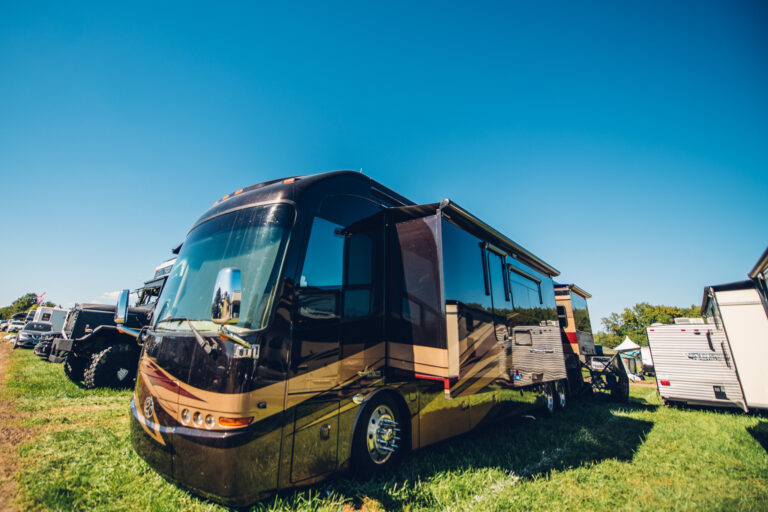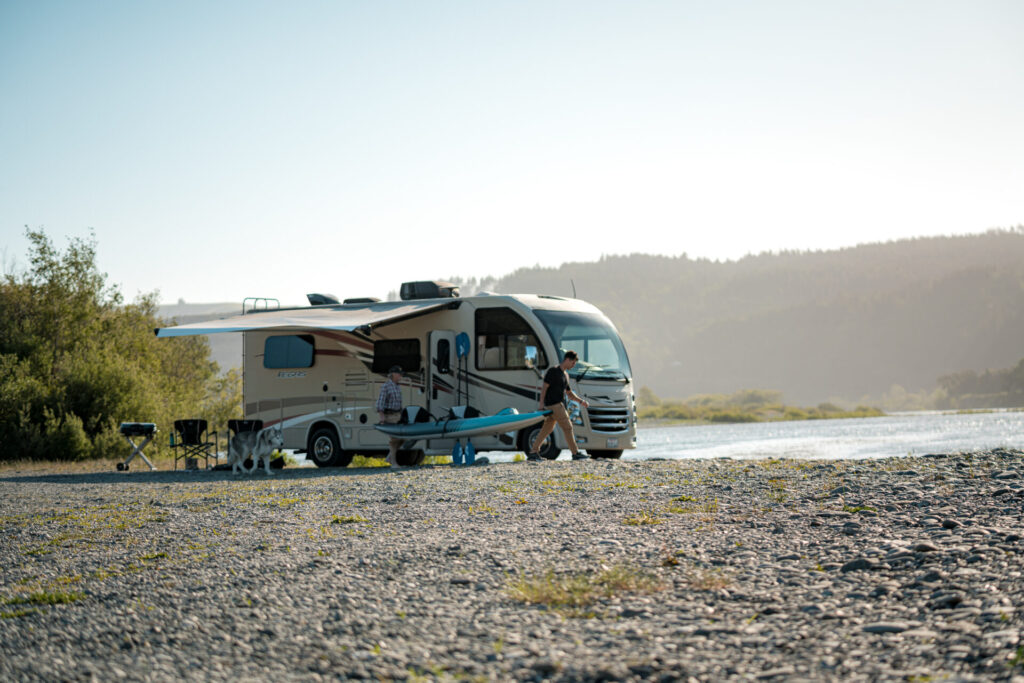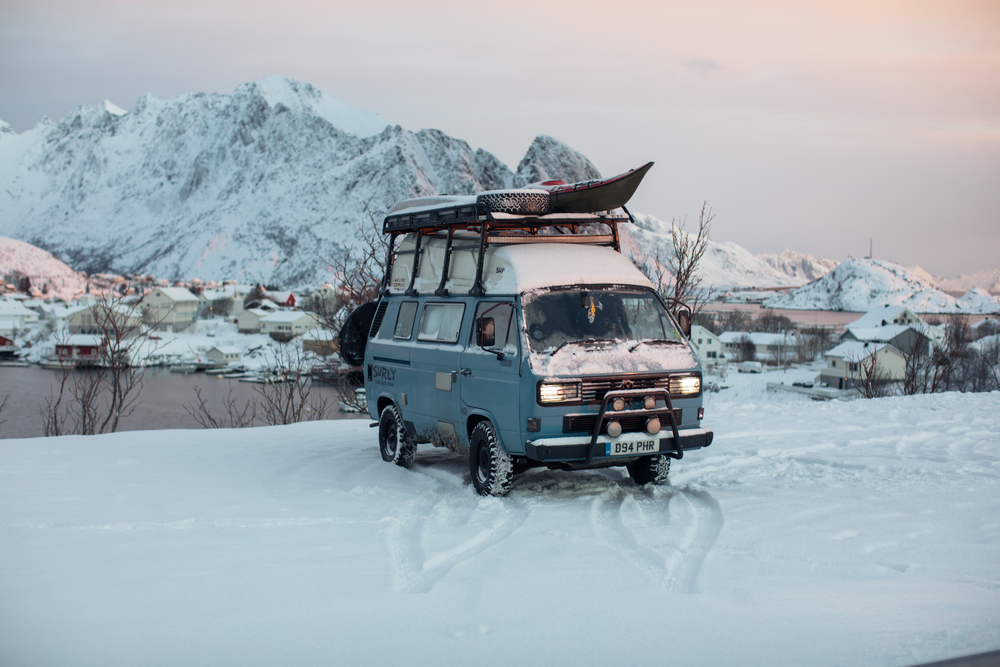
When we look at RV history, these vehicles have come a long way from the invention of the car to today’s luxury homes on wheels, sometimes complete with bedrooms and jacuzzis!
In the beginning, car lovers and nature lovers joined their passions in 1910 to create customized cars with lockers, bunks, and inventive water-holding tanks. During the 1920s, as roads started to improve, RV enthusiasm started to grow.
In more recent years, RVs have gone beyond what most of those early enthusiasts could have imagined! What will the next centuries bring?
RV history through the centuries
1901 to 1910
A 1909 edition of Motor Magazine showed a car pulling a trailer, and an article about Dr. Charles A. Morsman’s “automobile camping trailer” from around the same time reports the trailer had a bed, a small kitchen, and hot and cold running water thanks to an onboard water tank. Before long, simple wooden structures were constructed on the chassis of a car and the first motor homes were made.
The first motor home was built from a 3-ton Packard truck in 1910. It could sleep 11 people, was 28 feet long, had an icebox, toilet, and salon, and was 6 and a half feet wide. The motor home was used up until 1924.
1911 to 1920s
Campers continued to find more ingenious ways to adapt cars to their lifestyles, usually using wood and tents to construct their living spaces. These RVs and motor homes had refrigerators or ice boxes, kitchenettes, showers or baths, and other typical features. Some were even hooked up with telegraphs and electric lights.
The house car “gypsy van” was built in 1915. It weighed 8 tons, had an interior like an English manor house, and even had a rooftop garden. The first fifth-wheel camping trailer hit the road in 1917.
1921 to 1930
Until the 1920s, the most common car was the Ford Model T, and RVs had to be custom-built. In 1923, a Nomad house car was built on the chassis of the Ford Model TT. It was owned by novelists John Stanton and Mary Chapman, who owned it for 47 years and traveled in it to 24 states. In 1927, Leonard S Whittier built a custom RV on the chassis of a Brockway model” H’ bus chassis. It had wicker chairs, bookcases, a refrigerator, and a sink as well as an electric stove. It even had a septic tank.
1931 to 1940
This decade saw manufacturers begin to make travel trailers, ranging from very small to very large. In 1936, the Curtiss Aerocar was made by Glen Curtiss, an aircraft designer. In the same year, the Airstream Trailer Co. manufactured the Clipper, with riveted aluminum resembling an airplane. It could sleep four and carried a supply of water.
In 1937, the teardrop trailer which slept two became popular. In 1938, Commander Attilio Gatti, an Italian explorer, had two “jungle yachts” made for his trips to Africa. The jungle yachts had a dining car, bar, two bedrooms, and lighting, as well as a telephone. The same company built a 50-foot, 5th-wheel semi-trailer which included an observation deck, wine cellar, and all the latest conveniences. It was sold to an Indian Maharaja.

1941 to 1950
During World War II, RV growth halted as trailers and their materials were needed for other uses. After the war was over, manufacturers again began to create innovative house cars that changed the future of RVing almost instantly. Howard Hughes, the legendary movie producer, had 8 RVs built to serve as mobile dressing rooms. They had mahogany interiors, bathrooms, a refrigerator, a stove, and air conditioners.
In 1942, the US military purchased thousands of the “Palace Expando” a revolutionary trailer that expanded on both sides and had a shower and bath. Newly enlisted men and their families were housed in these trailers.
In 1946, a fascinating motor home was built on the chassis of a Chevrolet. According to historical sources, the owner of the RV couldn’t go on vacation without being stopped by curious people.
The Shoreland Tandem Town and Country was a 30-foot-long trailer with electric fixtures and 3 rooms. In 1948, Flxible Bus Company began manufacturing custom coaches.
1951 to 1960
RVs expanded in size and length with luxury interior décor and modern conveniences such as plumbing and bathrooms, as well as kitchens. The 50s were the decade of blossoming for the RV, and by the end, mobile homes and travel trailers were a definite part of the camper lifestyle. Terraces, and upstairs and downstairs models with separate private bedrooms were not uncommon in RVs at that point.
The Executive Flagship, built in 1952, was 65 feet long and weighed 18 tons. It had 10 wheels and was equipped with two bathrooms, wall-to-wall carpeting, and a 21-inch TV. It had a portable pool and diving board and retailed at $75,000.
An ingenious two-story RV design was created in 1955 and had two upstairs bedrooms, a main bedroom downstairs, and other conveniences found in modern RVs. It could sleep 8 people.
In 1958, the first pop-up truck camper was made, and five years later mass production began on these campers.
1959 saw Shasta enter the RV industry, and it soon became the most popular travel trailer of the era.

Unusual Vintage RV’s
Lampsteed Kampkar 1915
This early RV was manufactured by Anheuser-Busch. It was mounted on the chassis of a Ford Model T and could be yours for the low price of $535 (over $15,000 today). The camper was designed by Samuel B. Arthur and was sold in a completely knocked-down kit that could be shipped anywhere in the country. It was forest green, and a number of them are still available today. The Kampkar had two wide, comfortable beds courtesy of pullouts on either side. Four people could sleep in the two beds.
1927 Motorcoach aka ‘ Flordellen’
This custom RV was built long before RVs were a way of life. It is believed the RV had a woodwork interior though none of the pictures in existence show this. The Flordellen was 7 feet wide and 9 feet high, making it practical. It extended over 30 feet from the bumper to the observation platform and had electric heaters, a refrigerator and oven, and a stove. The main bedroom had two wicker chairs and cupboards. The upholstery was gray-green leather, and it had a complete bathroom finished in cream tile. The toilet emptied into a septic tank on the floor of the RV.
The driver and passenger seats converted into single beds, and a rear observation platform at the back of the vehicle afforded comfort with a view.
1937 Curtiss Aerocar
Built in Detroit, the Aerocar was commercially manufactured. It was designed by Glenn Curtiss, an aircraft designer who used those principles on the Aerocars. The trailers had no chassis, and the wheels were placed at the very end of the curved roadster. The trailer retailed at $5000. A tow car was custom-built for the trailer, and was chauffeur-driven, with pull-down windows. The rear seat converted into a bed, making it self-contained without the trailer. The car also had storage compartments and an intercom system connecting the car and trailer.
1937 Ford House Car
Produced in limited numbers, the Ford House Car had steel cladding and wood paneling. Only six were made every year. The interior was lined with wood, and the door frames were thick solid wood. A storage cabinet fit under the bed, and curtains and pull-down shades hung on all the windows. A fold-down table was fixed to the back of the driver’s seat
Flxible 1955
Flxible is now known as Custom Coach Corp. It was founded in 1913 and made the Flxible sidecars for motorcycles. Ford then made the Ford Roadster and sold it at $360, making the sidecar and motorcycle less popular. Flxible then turned to the RV market. In 1936, the company concentrated on coach conversions and introduced its Clipper range of buses. In 1955, Flxible started converting its buses into luxury motor homes. The interior of these coaches featured wood grain plastic drawers and cupboards. Coaches with a triangular mesh on the rear rift side of the vehicle had air conditioning.
Dodge and Travco 60s to 70s
These motorhomes were popular RVs built on a Dodge chassis. When Dodge stopped manufacturing the chassis, Travco went under. The Travco motorhome sold for $9,000 and enjoyed the bulk of the budding motorhome market. These motorhomes were revolutionary in shape and construction, using fiberglass and eliminating dry rot.
They had fully equipped kitchens, and the interiors were well-made and practical. The cars featured a dinette, refrigerator, double sink, floor coverings, and large closets.
Winnebago
Founded in 1958, Winnebago began by designing furniture for travel trailers. The first Winnebago was made in 1966 and was sold at half the price of competing models, and the name soon became synonymous with motor homes.

Volkswagen 1960’s
Volkswagen was already entrenched in America by the ’60s. The Westfalia camper by VW was manufactured in 1967. Around 100 of these conversions with electrical hookups and an ice box, curtains, and an optional popup tent were purchased in Germany and brought to the States.
The VW Camper Van: A Brief History
Speaking of Volkwagen, many people fondly remember sleeping in VW camper vans throughout the years! Here is a brief history of this iconic recreational – and practical, everyday – vehicle.
1947: The Beginning
Believe it or not, this campervan had humble beginnings. It was created to carry car parts around a humongous VW factory in Great Britain.
Before its invention, manufacturers used stripped-down VW Beetles for the task. In 1947, a Dutch VW importer named Ben Pon came up with an idea for a van based on the Beetle.
Out of this concept, the first VW camper van was born. In the beginning, it was simply a 170 cubic-foot box built on a four-wheeled chassis. Over the next few years, Volkswagen expanded on this concept and came up with almost 100 different body combinations with a variety of uses, including the camper van, pick-ups, ambulances, fire engines, and more.
1949: The Introduction of the “Splitty”
The ‘Splitty,’ or split window model VW camper van, was released in 1949. It is still one of the most popular models to this day. In fact, one of these vans in good condition can sell for as much as $50,000.
VW manufactured the ‘Splitty’ or, as they are officially known, the Type 2, until 1967. The first of its kind, the Bulli, was released as a Kombi and Panel van in 1949. They also released the Microbus one year later.
In the mid-1950s, the Splitty was introduced to the US market, where it experienced a wealth of success. In fact, almost 200,000 vans were sold by the early 1960s.
1967: The First Evolution of the Type 2
The Bay (an evolution of the Type 2) replaced the ‘Splitty’ design in 1967. Improvements included:
- A bigger body that could carry larger loads
- A speed increase of up to 80 mph
- A more comfortable ride
- A more powerful engine, which was later changed to a 2L model
- Better electrics
1975: The Bay Camper Bus
The Bay Camper Bus model rolled off of the assembly line in 1975. Although it had many of the same features as the Bay, the Bay Camper Bus had a different bay window design. This model soon gained a huge following among those who wanted to use it as a camper van or mobile home.
The new design of the Bay Camper Bus also proved to be an inspiration for several different companies. They configured the vans for more storage space, and so drivers could cook and sleep in them. They also created elevating roofs that could sleep more than 5 people. By 1975, the Hanover factory had released 4 million of these vans.
1979: The T4, T5, and the T25
VW stopped producing the Bay window bus, replacing it with the T25 in 1979. They also released the T4 and T5 models. Although these models didn’t become icons like the Splitty, they were wildly popular.
2014: The VW Camper Era Comes to an End
After almost 70 years, the VW camper van was retired in January 2014, mainly because VW could no longer adapt it to keep up with the safety regulations of the modern age. Despite being discontinued, the camper van is still a popular vehicle. You can expect to see these vehicles on the road for many years to come.
Since pioneers crossed the plains in covered wagons, humans have been fashioning various forms of RVs. It’s fascinating to glance at RV history and see how far motorhomes have come since then, and to dream about what future models will look like!

